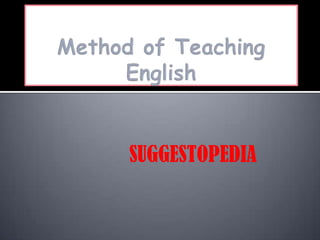
Suggestopedia
- 3. Suggestiopedia is now called Desuggestopedia to reflect the importance placed on desuggesting limitations on learning. We set up psychological barriers to learning and thus we do not use the full mental powers we have; in order to use our reserved capacity, the limitations we think we have need to be “desuggested.”.
- 4. Decoration. Furniture. Arrangement of the classroom. The use of soft music. The authoritative behavior of the teacher.
- 5. There are six principal theoretical components through which desuggestopedia and suggestopedia operate and that set- up access to reserves. Authority. Infantilization. Double- planedness. Intonation, rhythm, and concert psuedo- passiveness. Design syllabus
- 6. give control and authority to the teacher completely What makes a teacher authoritive? self-confidence Personal distance Acting ability Possitive attitude
- 7. Authority is also used to suggest a teacher-student relation like that of parent to child. In the child’s role the learner takes part in role playing, games, songs, and gymnastic exercise that help “the older student regain the self-confidence, spontaneity, receptivity of the child”.
- 8. The learner learn not only from the effect of direct instruction takes places.The bright decor of the classroom, the musical background, the shape of the chairs, and the personality of the teacher are considered as important instruction as the form of the instructional material itself.
- 9. Varying the tone and rhythm of presented material helps both to avoid boredom through monotony of repetition and dramatize, emotionalize, and give meaning to linguistic material. Both intonation and rhythm are coordinated with a musical background. The musical background helps to induce a relaxed attitude, which Lozanov refers to as concert pseudo-passiveness. This state is felt to be optimal for learning, in that anxieties and tension are relieved and power of concentration for new material is raised.
- 10. Objectives. Syllabus. Learning Activities. Roles of Learners, Teachers, and Materials.
- 11. course lasts 30 days, 10 units of study. Classes are held 4 hours a day, 6 days a week. The central focus of each unit is a dialogue consisting of 1200 word, or with an accompanying vocabulary list and grammatical commentary.
- 12. Question and answer Role play Listening exercises
- 13. Pseudo-passive state. Learners must not try to to figure out, Not to manipulate, or Not to study material Learners sit in a circle Encourages face-to-face exchange Activity participation
- 14. According to Lozanov, teachers should give attention to Absolute confidence His/her manners and dress Organizing the lesson (music choice, punctuality) Responding tactfully Modest enthusiasm
- 15. 1. Show absolute confidence in the method. 2. Display fastidious conduct in manners and dress. 3. Organize properly, and strictly observe the initial stages of the teaching process—this includes choice and play of music, as well as punctuality. 4. Maintain a solemn attitude towards the session. 5. Give tests and respond tactfully to poor papers (if any). 6. Stress global rather than analytical attitudes towards material. 7. Maintain a modest enthusiasm.
- 16. -Direct Supported Materials: Texts Tape -Indirect Supported Materials: Classroom fixtures Music Text books Learning environment
- 17. The 4-hours language class has three parts: Oral review section micro studies macro studies The class new material presentation and discussion The concert session
- 18. At the beginning of the session, all conversation stops for a minute, or two minutes, and the teacher listens to the music coming from a tape- recorder. The teacher waits and listens to several passages in order to enter into the mood of the music and then begins to read or recite the new text, his voice modulated in harmony with the musical phrases. The students follow the text in their textbooks where each lesson is translated into the mother tongue.
- 19. Between the first and second part of the concert, there are several of solemn silence. In some cases, even longer pauses can be given to permit the students to stir a little. Before beginning of the second part of the concert, there are again several minutes of silence and some phrases of the music are heard again before the teacher begins to read the text. Now the students close their textbooks and listen to the teacher’s reading. At the end, the students silently leave the room.
- 20. To accelerate the process of learning a foreign language for everyday communication To desuggest learners’ psychological barriers To activate learners’ ‘paraconscious’ part of the mind.
- 21. The teacher’s role: authority—being confident and trustable security—affording a cheerful classroom atmosphere The students’ role: relaxed—following the teacher’s instruction easily role play—enjoying in the new identity freely
- 22. Classroom atmosphere—decoration & posters A new name and occupation—to dispel fear or anxiety Handout—for advanced students No test, no assignment Conversation with translation in music—to activate the ’whole brain’ of the students Games,songs,role play—to streng then the material.
- 23. The teacher initiates interactions in two way— 1.the teacher to a group of students 2.the teacher to only one student The students respond through— 1.nonverbal actions 2.a few target language student- student interaction—role play.
- 24. Relaxed--psychological barriers are desuggested. Confident--the target language comes naturally. --Success is obtainable. Secure--assumption of a new identity.
- 25. Vocabulary is emphasized. Grammar is dealt with explicitly but minimally. Speaking communicatively is emphasized.
- 26. Native language is used to make the meaning of the dialog clear. As the course proceeds, the teacher uses the native language less and less.
- 27. Evaluation usually is conducted on students’ normal in-class performance, not through tests.
- 28. Errors are corrected gently, with the teacher using a soft voice.
- 29. • Motivation • self-confidence • Less stressed
- 30. Hardness of finding colorful environment Negative effects of direct translation Concentration problems.
- 31. Psychological barriers. Positive approach. In the Suggestopedia teaching it’s important to make student very relaxaed.
